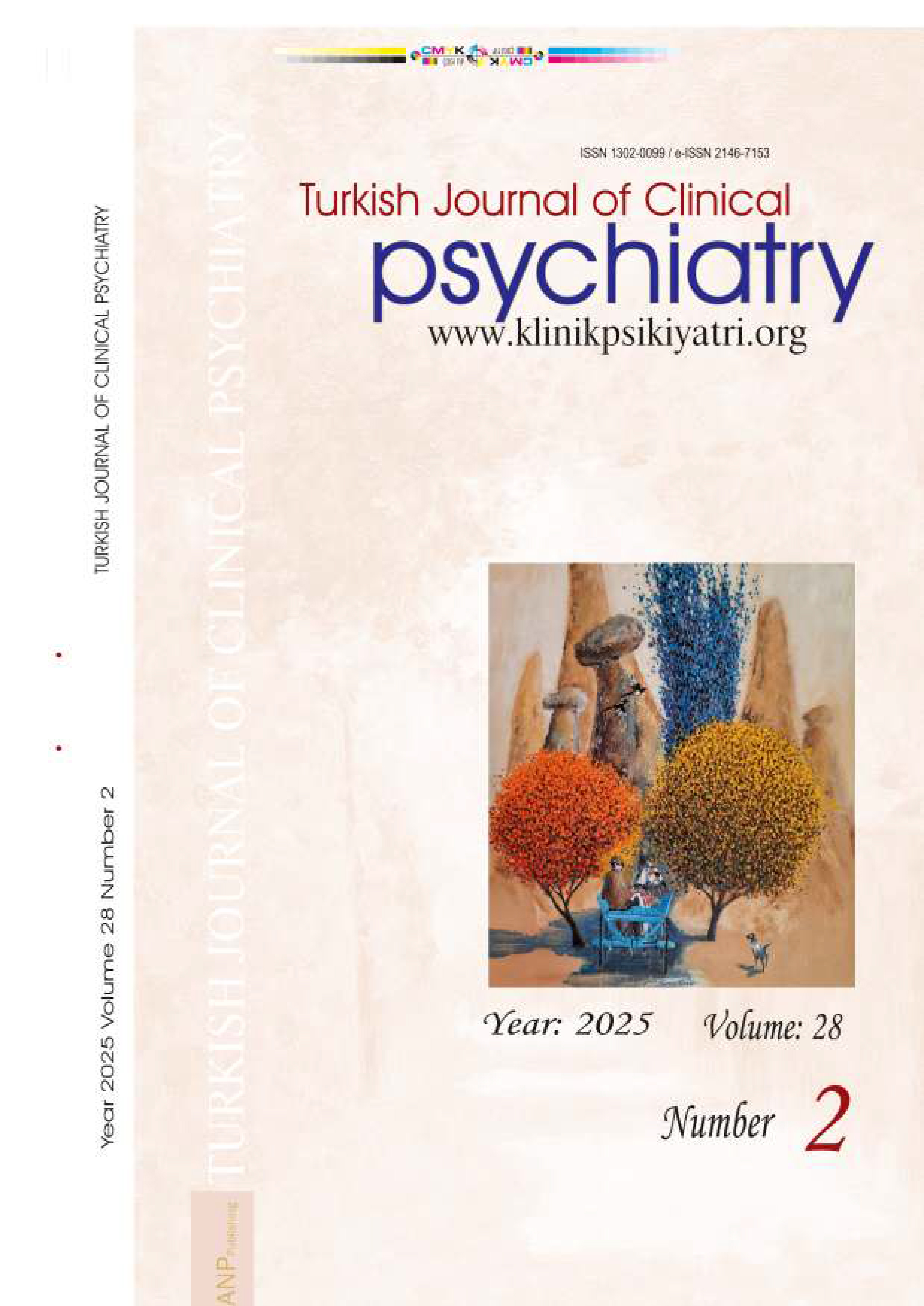





Volume: 19 Issue: 2 - 2016
| EDITORIAL | |
| 1. | Editorial Burhanettin Kaya Page 59 Abstract | |
| RESEARCH ARTICLE | |
| 2. | Reliability and Validity of Personal Risk Assessment Form (BIRDEF) for Children Under Institutional Care Kültegin Ögel, Sena Yücesan, Çiğdem Vaizoğlu, Emin Eraslan, Mesut Demirtaş, Serpil Yıldırım, Celal Sulu, İbrahim Kürşat Ergüt doi: 10.5505/kpd.2016.38257 Pages 60 - 72 INTRODUCTION: This research aims to develop a questionnaire which measures the risk factors and the needs of children under institutional care. The reliability and validity of the constructed questionnaire is also tested. METHODS: Individualized Risk Assessment Questionnaire (BIRDEF) consists of 66 questions. 304 children staying in 14 institutions under The Ministry of Family and Social Policies filled out the questionnaire. The same group of participants also completed Youth Self Report (YSR). Different interviewers applied the BIRDEF to randomly selected 32 participants, in order to test the interrater reliability of the questionnaire. RESULTS: Reliability analysis revealed that the BIRDEF was internally consistent with the Cronbach's alpha coefficient of 0.90. The interrater reliability coeficient was found 0.92 (p < 0.001). In exploratory factor analysis, 9 factors was obtained explaining %57 of total variance. Significant correlations were observed between Youth Self Report subscales and related questions of Individualized Risk Assessment Test. The correlation between total scores of YSR and BIRDEF was found 0.48 (p < 0.001). DISCUSSION AND CONCLUSION: Individualized Risk Assessment Test (BIRDEF) can be considered as a valid and reliable tool to determine the risk factors and the needs of the children under institutional care. |
| 3. | Diagnostic Stability in the Follow-up of Acute and Transient Psychotic Disorder: A Preliminary Study Nur Öztürk, Ürün Özer, Utku Uzun, Şakir Özen doi: 10.5505/kpd.2016.55265 Pages 73 - 77 INTRODUCTION: Acute and transient psychotic disorder differentiates from other psychotic disorders with acute onset, occurrence after stressful life events and ending with full remission. It is suggested to have good prognosis and response to treatment. In some of the patients, the diagnosis is switched to schizophrenia or mood disorders in the follow-up. This study aimed to determine sociodemographic and clinical features of patients diagnosed with acute and transient psychotic disorder, as well as changes in the diagnosis in a 5 year the follow-up. METHODS: The sample was constituted by patients who diagnosed with acute and transient psychotic disorder during their hospitalization in 2010. Medical records of these patients were examined restrospectively in 2015, including past 5 years. RESULTS: In a total number of 47 patients, 17 were female and 30 were male. Mean age was 32.2±9.9 years. The majority were single (51.1%) unempoyed (85.1%) and living with their families (87.2%). The rate of patients who have been rehospitalized was 51.1%, and 8.5% of patients have not applied again. Most common diagnoses in the follow-up were atypical psychosis (38.3%), schizophrenia (25.5%) and bipolar affective disorder (12.8%). In 2 patients the diagnosis was psychotic disorder due to alcohol/substance abuse and 3 patients had a neurological disease. DISCUSSION AND CONCLUSION: This study revealed that the diagnosis of acute and transient psychotic disorder, have been changed to atypical psychosis or schizophrenia in the follow-up in the majority of patients. Therefore, the cases who diagnosed with acute and transient psychotic disorder, especially if they carry risk factors, should be evaluated in detail in terms of prodromal period of schizophrenia. Furthermore, a close follow-up would be beneficial. |
| REVIEW | |
| 4. | Predictive Factors of Antipsychotic Treatment Response in Patients with First Episode Schizophrenia Sefa Vayısoğlu doi: 10.5505/kpd.2016.69775 Pages 78 - 86 Schizophrenia is an illness which is chronic that leads to disability. Particularly obtaining sufficient treatment response in patients with first episode schizophrenia is important in determining the course of the illness. Predicting treatment response with antipsychotic drugs would allow to obtain efficient clinical response by reducing unnecessary drug use and enhance the adherence to treatment. In this context, considering the importance of topic, this review is written out relevant to predictive factors of antipsychotic treatment response in patients with first episode schizophrenia. Electronic search was conducted for this review in Pubmed database. Although there are varied links between drug response and both biological, including pharmacological, neuroimaging and electroencephalography (EEG) findings, and clinical, including duration of untreated psychosis, antipsychotic agents which are used in treatment, soft neurological signs, kind and severity of psychotic symptoms and neurophysiologic indicator of frontal lobe function (NoGo Anteriorization, NGA), variables in studies which are conducted in this field, there is a need for further studies as a conclusion. |
| 5. | Relationship Between Bullying Experiences Related with Gender Identity, Sexual Orientation and Social Support and Psychological Well-Being Fatma Mahperi Uluyol doi: 10.5505/kpd.2016.77487 Pages 87 - 96 Despite all the progress made in the Lesbian Gay Bisexual and Transsexual (LGBT) area of study, especially where media representations are considered, violence, discrimination, and marginalization toward those individuals continues. Mental health studies report that LGBT individuals, as opposed to the general population, have higher rates of psychological and physiological problems. It is assumed that this situation occurs due to the adverse effects of exposure to the LGBT identity related with negative life experiences of these individuals on psychological well-being. In the current paper negative life experiences, discrimination and the marginalizing experiences of LGBT individuals are discussed in relation to the concept of bullying. Bullying behaviors that are experienced by LGBT individuals due to their LGBT identities may have negative effects on their current and later life well-being status via shaping their self-perceptions and expectations about others. In this regard, this paper examined the effects of exposure to bullying and social support on the psychological well-being of LGBT children and young adults. Firstly, the relationship between bullying experiences and LGBT identity was discussed. Secondly, the effects of the LGBT identity related to the exposure to bullying experiences on psychological well-being were examined. Thirdly, the role of social support in this process was considered. Lastly, bullying prevention strategies for LGBT people was mentioned. |
| CASE REPORT | |
| 6. | Efficiency of EMDR on a woman with vaginismus who has repetitive sexual assault in childhood Yasemin Hoşgören Alıcı, Bilge Bilgin Kapucu, Burhanettin Kaya doi: 10.5505/kpd.2016.96268 Pages 97 - 100 Vaginismus is a type of sexual dysfunction in which caused by spasm of the vaginal musculature prevents penetrative intercourse. The presence of recurrent or persistent involuntary spasm of the musculature of the outer third of the vagina that interferes with sexual intercourse. In many cases frequently anxiety, quality of the maritial relationship, sexual functioning of partner and lack of knowledge about elemantary anatomy and sexuality are some of the suggested factors with a probable role in the etiology of vaginismus, however the findings are inconsistent. In the recent studies, the conditioned fear response to a certain stimulant was suggested as one of the responsible mechanism of the formation way of this vaginal response. According to these results, psychotherapeutical and pharmacological treatment modalities that use for reducing anxiety and fear are the treatment options that prefered nowadays. Eye Movement Desensitization and Reprocessing (EMDR) therapy is used especially in Post-Traumatic Stress Disorder (PTSD) and other many psychiatric disorders. In Eye Movement Desensitization and Reprocessing therapy, bilateral stimulation of eye movement is provided by the therapist. While following the movement of the therapists’ hand, the patient focus on the internal representations of the traumatic experience. Dual attention stimulation sets are continued until anxiety disappear or greatly reduce. In this case report, we discussed a patient who presented with therapy-resistant vaginismus secondary to childhood sexual trauma and was treated successfully with the Eye Movement Desensitization and Reprocessing therapy. |
| 7. | A Case of Partial DiGeorge Syndrome with Attention Deficit and Hyperactivity Disorder and Specific Learning Disorder Sabide Duygu Tunas, Çağatay Uğur, Zeynep Göker, Özden Şükran Üneri doi: 10.5505/kpd.2016.44153 Pages 101 - 104 DiGeorge Syndrome (DGS) is the most seen microdeletion syndrome and its prevalance varies from 1/4000 to 1/6000. Over embriogenesis, a deletion of an approximately 3 Mb frame from 22q11.2 results in this syndrome and its clinical features varies from congenital heart and gross vessels anomalies, hypocalcemia, respiratory problems, leucomotor or urogenitale system anomalies, hearing loss, to developmental delay. Alongside different clinical features and phenotypes, these patients should be followed up on psychiatric symptoms and disorders such as speech delay, specific learning difficulties (SLD), mental retardation, attention deficit hyperactivity disorder (ADHD), autism, anxiety, depression and even schizophrenia and other pcychotic disorders. This case, diagnosed with partial DGS and followed by immunology, cardiology, endocrinology and neurology departments, admitted to our clinic on account of his difficulties in learning and inattention. The patient was diagnosed with ADHD and SLD, then pharmacotherapy and individual educational programme were planned. The insufficient expression of the catecolamine-O-methyl-transferase (COMT) gene located in the 22q11.2 gene could very well play a role in both the etiology of ADHD and SLD. There is still no clear causative relation between these, so there is a need to clarify this with further studies. As seen in our case, the patients with DGS and having some inattention or learning difficulties are needed to be examined by the child psychiatrists. Treatment protocols related to these patients’ symptoms would be evaluated with a multidisciplinary attitude. |










